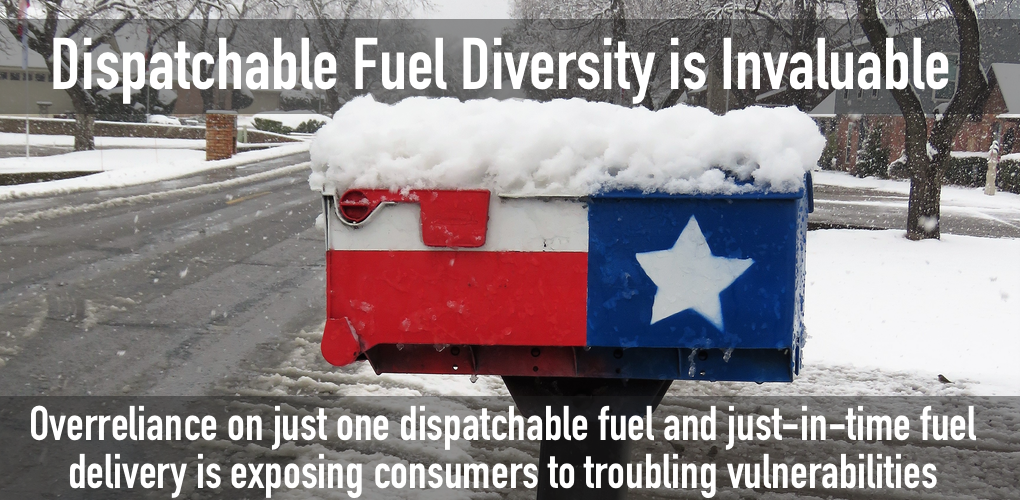
Dispatchable Fuel Diversity is Invaluable
Does fuel diversity matter? Or, to put a finer point on it, does dispatchable fuel diversity matter? If February taught us anything, the answer is a resounding yes.
Along with the Texas grid disaster, there were two neighboring grids pushed to the brink by the same unrelenting cold but both fared much better. The Southwest Power Pool (SPP) and the Midcontinent Independent System Operator (MISO) weathered the crisis without nearly the interruption in service. While there are considerable differences between these grids – market design and weatherization not least among them – greater balance afforded by coal generation sticks out. It was a difference in dispatchable fuel diversity that proved invaluable when it mattered most.
On February 22nd, Oklahoma Governor Kevin Stitt addressed the media on the grid crisis and how Oklahoma and the SPP were able to pull through. He said, “Renewable sources like wind and solar dropped to almost zero production. Natural gas wells froze and compressor stations went offline. That left utility companies really scrambling to buy extra energy on the spot market at skyrocketing prices.” He continued, “Wind is normally about 40 percent and it dropped to 10 percent. Coal in Oklahoma is normally 10 percent and it went to 40 percent. I’ve talked to several other Governors that coal was really bailing us out.”
Up and down SPP and MISO territory, coal came to the rescue. On the MISO grid, coal generation met the majority of power demand when consumers in the 15-state grid needed it most. Coal was an insurance policy tens-of-millions of Americans were fortunate to have.
When the Wind Doesn’t Blow and the Gas Doesn’t Flow
In Texas, wind generation received much of the initial blame for the crisis and it was certainly not without cause. Even wind’s most strident defenders have offered the stirring talking point that its performance during the emergency was “reliably unreliable.” In other words, wind was precisely the no-show grid planners expected it to be. But while every power source faced challenges in Texas, it was the gas generating fleet and gas infrastructure system that promised the most but couldn’t deliver.
As The Wall Street Journal reported, “The failure of Texas’ gas infrastructure to deliver the expected amounts of supplies exposed a dangerous vulnerability for a fuel the oil industry claims is more reliable than rival sources.”
From wellhead to pipeline and then generating station, gas infrastructure struggled. The Journal found that gas production in Texas fell from around 21 billion cubic feet of gas to less than 14 billion. Spot gas prices in Houston climbed more than 12,000% to $400 per million British thermal units. And gas-fired power generation fell about 31%.
“The natural-gas story is a case of systemic failure,” Ramanan Krishnamoorti, the chief energy officer at the University of Houston, told The Journal.
The International Energy Agency, reviewing the crisis for a global audience, drew much the same conclusion. Their analysts found that, “Texas has a power shortage because it has a gas shortage. Given the key role gas‑fired generation plays in many power systems today, resilient power systems depend on resilient natural gas systems.”
Voters Take Notice
The Texas grid crisis and the comparative resilience of the SPP and MISO grids have not gone unnoticed across the country. California’s grid crisis this past summer with its own rolling blackouts also seems to have left a lasting impression.
In polling conducted just last week of 1,980 registered voters, Morning Consult found that 7 in 10 support maintaining baseload, on-demand power plants, such as coal plants, to support the reliable supply of electricity.
While Americans don’t often think about the electricity grid, when they do it’s often because something has gone wrong. What they tell pollsters and their utilities, time and again, is that above all else, affordability and reliability matter most. And they recognize coal generation plays an important part in providing them.
As the transition to variable sources of power accelerates, maintaining the affordable, reliable power consumers expect is only getting more challenging. And, as we are finding out, overreliance on just one dispatchable fuel and just-in-time fuel delivery is exposing consumers to troubling vulnerabilities.
As the IEA concluded in its review of the Texas grid crisis, “…[it’s] a reminder that electricity security cannot be taken for granted. It must remain a top priority for policy makers, especially as electricity becomes more important for the entire energy system with increased electrification of many sectors and threats to energy security evolve and multiply… Market designs and regulations need to improve to make best use of existing assets and to encourage new investments both in supply and demand for flexibility and capacity adequacy.”
The world is being told to value the capacity it has, to shape markets to better value balance and fuel security and to ensure reliability isn’t taken for granted. The haphazard U.S. approach to the energy transition is quickly becoming a case study in mistakes made and missteps best avoided. Now is the moment to learn and to make sure these early regional failures don’t become an avoidable national crisis.
- On March 3, 2021
